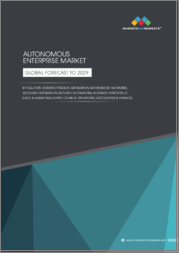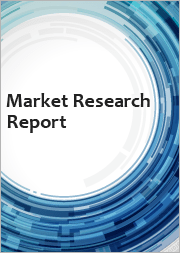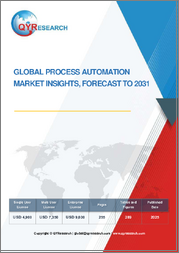
|
시장보고서
상품코드
1552971
세계의 자율 기업 시장 : 솔루션별, 비즈니스 기능별 - 예측(-2029년)Autonomous Enterprise Market by Solutions (Robotic Process Automation, Autonomous Networks, Accounts Automation, Security Automation), Business Functions (IT, Sales & Marketing, Supply Chain & Operations, Accounting & Finance) - Global Forecast to 2029 |
||||||
세계 자율 기업 시장 규모는 2024년 505억 달러, 2029년 1,140억 달러에 이를 것으로 추정되며(2024-2029년) CAGR로 17.6%의 성장이 예상됩니다.
디지털 시스템과 자동화 시스템에 대한 의존도가 높아짐에 따라 기업의 사이버 보안 위협의 특성이 첨단으로 바뀌고 있습니다. 자율 기업은 위협을 신속하게 감지하고 대응하는 첨단 보안 메커니즘이 필요하며, 이에 대해 남아있는 인프라는 지속적으로 싸워질 것입니다. AI 기반 사이버 보안 솔루션은 자동화된 위협 탐지 및 대응을 위한 시스템을 포함하여 기업 데이터 및 인프라 보호에 매우 설득력이 있습니다. 이를 통해 취약성을 끊김 없이 모니터링하고 새로운 위협에 적응하고 자율적인 운영 속에서 무결성을 확보할 수 있는 자율적인 보안 솔루션이 더욱 넓어지고 더 나은 것으로 되어 있습니다.
| 조사 범위 | |
|---|---|
| 조사 대상년도 | 2019-2029년 |
| 기준년 | 2023년 |
| 예측 기간 | 2024-2029년 |
| 단위 | 10억 달러 |
| 부문 | 제공별, 비즈니스 기능별, 용도별, 업계별, 지역별 |
| 대상 지역 | 북미, 유럽, 아시아태평양, 중동, 아프리카, 라틴아메리카 |
RPA 솔루션은 예측 기간 동안 가장 큰 시장 점유율을 차지합니다.
로봇식 공정 자동화(RPA)은 조직이 빈도가 높고 복잡도가 낮은 다양한 형태의 프로세스를 자동화하는 데 도움이 되는 혁신적인 기술입니다. RPA는 인간 행동을 복제하고 다양한 디지털 플랫폼에서 시간 효율적인 방식으로 작업을 수행하여 비즈니스 성능을 향상시킵니다. 이를 통해 생산성이 향상되고 비용 절감으로 이어질 뿐만 아니라 인간의 노동력을 업무 활동에서 해방하고 보다 전략적이고 창의적인 활동에 집중할 수 있습니다.
"예측 기간에 아시아태평양이 가장 높은 성장률을 나타낼 것으로 보입니다."
시장의 주요 촉진요인은 아시아태평양의 자율 기업을 견인하는 인구와 다양한 사회, 정치, 경제 시스템 등입니다. 우선 아시아태평양 국가에서는 디지털화와 기술 개발이 진행되어 자율 기업의 성장이 촉진되고 있습니다. 자율 기업의 배포를 이 지역에 적합하게 하는 주요 요인으로는 강력한 IT 환경의 특수성 외에도 클라우드, 빅데이터 애널리틱스, AI, ML을 비롯한 중요한 실현 기술의 이용 가능 성 등이 있습니다. 아시아태평양의 자율 기업 시장은 유리한 정부 정책과 투자 프로그램, 주요 기업, 연구 기관, 신생 기업의 협력으로 성장하고 있습니다.
이 보고서는 세계 자율 기업 시장에 대한 조사 분석을 통해 주요 촉진요인과 억제요인, 경쟁 구도, 미래 동향 등의 정보를 제공합니다.
목차
제1장 서론
제2장 조사 방법
제3장 주요 요약
제4장 중요 인사이트
- 자율 기업 시장의 기업에 있어서 매력적인 기회
- 자율 기업 시장 : 제공별(2024년)
- 자율 기업 시장 : 솔루션별(2024년)
- 자율 기업 시장 :서비스별(2024년)
- 자율 기업 시장 : 비즈니스 기능별(2024년)
- 자율 기업 시장 :업계별(2024년)
- 북미의 자율 기업 시장 : 용도별, 제공별(2024년)
제5장 시장 개요와 산업 동향
- 소개
- 시장 역학
- 성장 촉진요인
- 억제요인
- 기회
- 과제
- 자율 기업의 진화
- 생태계 분석
- 사례 연구 분석
- 밸류체인 분석
- 규제 상황
- 특허 분석
- 기술 분석
- 주요 기술
- 보완 기술
- 인접 기술
- 가격 분석
- 주요 기업의 평균 판매 가격 동향 : RPA 솔루션별(월액)
- 자율 기업 계정 자동화 솔루션의 참고 가격 분석(월액)
- Porter's Five Forces 분석 모델
- 고객사업에 영향을 주는 동향/혼란
- 주요 이해관계자와 구매 기준
- 현재의 비즈니스 모델과 새로운 비즈니스 모델
- 주요 컨퍼런스 및 이벤트(2024-2025년)
- 자율 기업 시장용 기술 로드맵
- 자율 기업 솔루션의 모범 사례
- 투자와 자금조달 시나리오
- 자율 기업 시장에 대한 AI/생성형 AI의 영향
- 자율 기업에서의 생성형 AI의 통합
- 자율 기업에 있어서의 생성형 AI의 이용 사례
- 자율 기업에 생성형 AI를 활용하는 모범 사례
- 자율 기업에서의 생성형 AI의 동향
- 자율 기업에서의 생성형 AI의 미래
제6장 자율 기업 시장 : 제공별
- 소개
- 솔루션
- 로봇식 공정 자동화(RPA)
- 자율 네트워크
- 계정 자동화
- 보안 자동화
- 자율 에이전트
- 기타 솔루션
- 서비스
- 전문 서비스
- 매니지드 서비스
제7장 자율기업 시장 : 비즈니스 기능별
- 소개
- 회계 및 재무
- IT
- 인재
- 판매 마케팅
- 공급망 및 경영
제8장 자율 기업 시장 : 용도별
- 소개
- 프로세스 자동화
- 고객 및 직원 인게이지먼트
- 주문 관리
- 신용평가 및 관리
- 예지보전
- 기타 용도
제9장 본 자율 기업 시장 : 업계별
- 소개
- BFSI
- IT 및 ITES
- 통신
- 소매 및 E-Commerce
- 미디어 및 엔터테인먼트
- 수송 및 물류
- 의료
- 제조
- 정부 및 방위
- 기타 산업
제10장 자율 기업 시장 :지역별
- 소개
- 북미
- 북미의 거시경제 전망
- 미국
- 캐나다
- 유럽
- 유럽의 거시 경제 전망
- 영국
- 독일
- 프랑스
- 이탈리아
- 스페인
- 북유럽 국가
- 기타 유럽
- 아시아태평양
- 아시아태평양의 거시 경제 전망
- 중국
- 일본
- 인도
- 호주 및 뉴질랜드
- 한국
- 기타 아시아태평양
- 중동 및 아프리카
- 중동 및 아프리카의 거시 경제 전망
- 중동
- 아프리카
- 라틴아메리카
- 라틴아메리카의 거시 경제 전망
- 브라질
- 멕시코
- 기타 라틴아메리카
제11장 경쟁 구도
- 소개
- 주요 기업의 전략/유력 기업
- 수익 분석
- MICROSOFT
- IBM
- CISCO
- CHECK POINT SOFTWARE
- PEGASYSTEMS
- 시장 점유율 분석
- 기업 평가 매트릭스: 주요 기업(2023년)
- 기업평가 매트릭스: 스타트업/중소기업(2023년)
- 경쟁 시나리오와 동향
- 브랜드/제품 비교
- 주요 자율 기업 시장 벤더의 기업 평가와 재무 지표
제12장 기업 프로파일
- 주요 기업
- MICROSOFT
- IBM
- CHECK POINT SOFTWARE
- PEGASYSTEMS
- CISCO SYSTEMS
- SAP
- HPE
- ATOS
- ORACLE
- AMAZON WEB SERVICES
- SAGE
- NICE
- PALO ALTO NETWORKS
- BLUE PRISM
- UIPATH
- APPIAN
- AUTOMATION ANYWHERE
- 스타트업/중소기업
- TANGENTIA
- DRIVENETS
- NINTEX
- SYNDER
- FETCH.AI
- ROSSUM
- DIGITATE
- MENDIX
- ROCKETBOT
- AUTOMATIONEDGE
제13장 인접 시장 및 관련 시장
- 소개
- RPA 및 하이퍼 오토메이션 시장 - 세계 예측(-2027년)
- 시장의 정의
- 시장 개요
- 보안 자동화 시장 - 세계 예측(-2028년)
- 시장의 정의
- 시장 개요
제14장 부록
JHS 24.09.24The Autonomous enterprise market is estimated to be USD 50.5 billion in 2024 to USD 114.0 billion in 2029 at a CAGR of 17.6% from 2024 to 2029. Increased dependence on digital and automated systems has changed the nature of cybersecurity threats for businesses to sophisticated ones. Autonomous enterprise needs advanced security mechanisms that detect and respond to threats in time; against these, the remaining infrastructure will be continuously pitted. AI-based cybersecurity solutions, including systems for automated threat detection and response, have become very compelling for protection of enterprise data and infrastructure. This has further and better opened wide autonomous security solutions that can uninterruptedly monitor for vulnerabilities, adapt to new threats, and ensure integrity within the autonomous operation.
| Scope of the Report | |
|---|---|
| Years Considered for the Study | 2019-2029 |
| Base Year | 2023 |
| Forecast Period | 2024-2029 |
| Units Considered | USD (Billion) |
| Segments | By Offering, Business Function, Application, Vertical, and Region |
| Regions covered | North America, Europe, Asia Pacific, Middle East & Africa, and Latin America |
During the forecast period, the RPA solution to contributed the largest market share in the Aautonomous enterprise market.
Robotic Process Automation (RPA) is an innovative technology that helps organizations to automate various forms of high touch, low-complexity processes. They replicate human behavior and perform tasks on different digital platforms in a time-efficient manner to enhance operational performance. This drives up productivity and leads to lower costs, as well as liberates human workers from operational activities so their effort can be solely focused on activities that are more strategic and creative.
"Asia Pacific will register the highest growth rate during the forecast period."
The autonomous enterprise market in Asia Pacific includes China, Japan, India, South Korea, ANZ, and remaining countries in Asia Pacific. The rest of Asia Pacific is made of countries such as Singapore, Malaysia, and Thailand among others. The key drivers of market include populace and varied social, political and economic systems driving autonomous enterprise in the Asia-Pacific region. First, there is increased digitalization and technological development in the Asia Pacific countries facilitating growth of autonomous enterprise. Some of the key factors that make the autonomous enterprise deployment suitable for the region are the strong IT environment peculiarities, the availability of key enabling technologies including and not limited to, cloud, big data analytics, AI and ML. The autonomous enterprise market in the Asia-Pacific region is growing due to favorable government policies and investment programs as well as cooperation between key players, research institutions, and startups.
Breakdown of primaries
The study contains insights from various industry experts, from solution vendors to Tier 1 companies. The break-up of the primaries is as follows:
- By Company Type: Tier 1 - 62%, Tier 2 - 23%, and Tier 3 - 15%
- By Designation: C-level -38%, D-level - 30%, and Managers - 22%
- By Region: North America - 38%, Europe - 15%, Asia Pacific - 35%, Middle East & Africa- 7%, and Latin America- 5%.
The major players in the Autonomous enterprise market are Microsoft(US), IBM (US), Check Point (US), Pegasystems (US), Cisco (US), SAP (Germany), Atos (France), AWS (US), Oracle (US), HPE (US), Sage (UK), NICE (Israel), Palo Alto Networks (US), Blue Prism (UK), UiPath (New York), Appian (US), Automation Anywhere (US), Tangentia (Canada), Drivenets (Israel), Nintex (US), Synder (US), Fetch.ai (England), AutomationEdge (US), Rocketbot (Chile), Rossum (UK), Digitate (US), and Mendix (US). These players have adopted various growth strategies, such as partnerships, agreements and collaborations, new product launches, enhancements, and acquisitions to expand their autonomous enterprise footprint.
Research Coverage
The market study covers the autonomous enterprise market size across different segments. It aims to estimate the market size and the growth potential across various segments, including offering, business function, application, vertical, and regions. The study includes an in-depth competitive analysis of the leading market players, their company profiles, key observations related to product and business offerings, recent developments, and market strategies.
Key Benefits of Buying the Report
The report will help market leaders and new entrants with information on the closest approximations of the global autonomous enterprise market's revenue numbers and subsegments. It will also help stakeholders understand the competitive landscape and gain more insights to better position their businesses and plan suitable go-to-market strategies. Moreover, the report will provide insights for stakeholders to understand the market's pulse and provide them with information on key market drivers, restraints, challenges, and opportunities.
The report provides insights on the following pointers:
Analysis of key drivers (rising adoption of RPA, and progress being driven by convergence of cloud, data and IoT infrastructures), restraints (high cost of investment, regulatory and enterprise constraints, concerns related to data privacy), opportunities (generative AI Revolution Creating the Next Phase of Autonomous Enterprise) and challenges (ethical and legal constraints, and risks of Autonomous AI in Enterprise Environments) influencing the growth of the autonomous enterprise market.
Product Development/Innovation: Detailed insights on upcoming technologies, research and development activities, and new product and service launches in the autonomous enterprise market. Market Development: Comprehensive information about lucrative markets - the report analyses various regions' autonomous enterprise markets. Market Diversification: Exhaustive information about new products and services, untapped geographies, recent developments, and investments in the autonomous enterprise market. Competitive Assessment: In-depth assessment of market shares, growth strategies, and service offerings of leading players such as Microsoft(US), IBM (US), Check Point (US), Pegasystems (US), Cisco (US), SAP (Germany), Atos (France), AWS (US), Oracle (US), HPE (US), Sage (UK), NICE (Israel), Palo Alto Networks (US), Blue Prism (UK), UiPath (New York), Appian (US), Automation Anywhere (US), Tangentia (Canada), Drivenets (Israel), Nintex (US), Synder (US), Fetch.ai (England), AutomationEdge (US), Rocketbot (Chile), Rossum (UK), Digitate (US), and Mendix (US).
TABLE OF CONTENTS
1 INTRODUCTION
- 1.1 STUDY OBJECTIVES
- 1.2 MARKET DEFINITION
- 1.3 STUDY SCOPE
- 1.3.1 MARKET SEGMENTATION
- 1.3.2 INCLUSIONS AND EXCLUSIONS
- 1.3.3 YEARS CONSIDERED
- 1.4 CURRENCY CONSIDERED
- 1.5 STAKEHOLDERS
2 RESEARCH METHODOLOGY
- 2.1 RESEARCH DATA
- 2.1.1 SECONDARY DATA
- 2.1.1.1 Key data from secondary sources
- 2.1.2 PRIMARY DATA
- 2.1.2.1 Breakup of primary interviews
- 2.1.2.2 Key primary interview participants
- 2.1.2.3 Key insights from industry experts
- 2.1.1 SECONDARY DATA
- 2.2 MARKET BREAKUP AND DATA TRIANGULATION
- 2.3 MARKET SIZE ESTIMATION METHODOLOGY
- 2.3.1 TOP-DOWN APPROACH
- 2.3.1.1 Supply-side analysis
- 2.3.2 BOTTOM-UP APPROACH
- 2.3.3 AUTONOMOUS ENTERPRISE MARKET ESTIMATION: DEMAND-SIDE ANALYSIS
- 2.3.1 TOP-DOWN APPROACH
- 2.4 RESEARCH ASSUMPTIONS
- 2.5 RESEARCH LIMITATIONS
- 2.6 RISK ASSESSMENT
3 EXECUTIVE SUMMARY
4 PREMIUM INSIGHTS
- 4.1 ATTRACTIVE OPPORTUNITIES FOR PLAYERS IN AUTONOMOUS ENTERPRISE MARKET
- 4.2 AUTONOMOUS ENTERPRISE MARKET, BY OFFERING, 2024
- 4.3 AUTONOMOUS ENTERPRISE MARKET, BY SOLUTION, 2024
- 4.4 AUTONOMOUS ENTERPRISE MARKET, BY SERVICE, 2024
- 4.5 AUTONOMOUS ENTERPRISE MARKET, BY BUSINESS FUNCTION, 2024
- 4.6 AUTONOMOUS ENTERPRISE MARKET, BY VERTICAL, 2024
- 4.7 NORTH AMERICA: AUTONOMOUS ENTERPRISE MARKET, BY APPLICATION AND OFFERING, 2024
5 MARKET OVERVIEW AND INDUSTRY TRENDS
- 5.1 INTRODUCTION
- 5.2 MARKET DYNAMICS
- 5.2.1 DRIVERS
- 5.2.1.1 Convergence of cloud, data, and IoT infrastructures
- 5.2.1.2 Rising adoption of RPA
- 5.2.2 RESTRAINTS
- 5.2.2.1 Concerns related to data privacy
- 5.2.2.2 Discrepancies between expectations and operational capabilities
- 5.2.2.3 High investment costs
- 5.2.3 OPPORTUNITIES
- 5.2.3.1 Emergence of generative AI
- 5.2.4 CHALLENGES
- 5.2.4.1 Ethical and legal constraints
- 5.2.4.2 Mitigating ethical and practical concerns in autonomous AI enterprise deployment
- 5.2.1 DRIVERS
- 5.3 EVOLUTION OF AUTONOMOUS ENTERPRISE
- 5.4 ECOSYSTEM ANALYSIS
- 5.5 CASE STUDY ANALYSIS
- 5.5.1 CASE STUDY 1: KOMATSU AUSTRALIA ACHIEVES END-TO-END AUTOMATION WITH MICROSOFT POWER AUTOMATE
- 5.5.2 CASE STUDY 2: SOFTBANK OVERCOMING AUTOMATION BOTTLENECKS AND PIONEERING COMPREHENSIVE PROCESS AUTOMATION
- 5.5.3 CASE STUDY 3: AGCO ENHANCES EFFICIENCY AND REDUCES COSTS WITH INTELLIGENT RPA FOR SAP JOURNALING
- 5.5.4 CASE STUDY 4: SUN LIFE FINANCIAL STREAMLINING OPERATIONS AND MAXIMIZING ROI WITH PEGASYSTEMS
- 5.6 VALUE CHAIN ANALYSIS
- 5.7 REGULATORY LANDSCAPE
- 5.7.1 REGULATORY BODIES, GOVERNMENT AGENCIES, AND OTHER ORGANIZATIONS
- 5.8 PATENT ANALYSIS
- 5.8.1 METHODOLOGY
- 5.8.1.1 List of major patents
- 5.8.1 METHODOLOGY
- 5.9 TECHNOLOGY ANALYSIS
- 5.9.1 KEY TECHNOLOGIES
- 5.9.1.1 5G
- 5.9.1.2 Cloud computing
- 5.9.2 COMPLEMENTARY TECHNOLOGIES
- 5.9.2.1 Edge computing
- 5.9.2.2 Blockchain
- 5.9.2.3 Artificial intelligence (AI) and machine learning (ML)
- 5.9.3 ADJACENT TECHNOLOGIES
- 5.9.3.1 Augmented reality (AR) and virtual reality (VR)
- 5.9.3.2 Big data analytics
- 5.9.3.3 Cybersecurity solutions
- 5.9.1 KEY TECHNOLOGIES
- 5.10 PRICING ANALYSIS
- 5.10.1 AVERAGE SELLING PRICE TREND OF KEY PLAYERS, BY RPA SOLUTION PER MONTH
- 5.10.2 INDICATIVE PRICING ANALYSIS FOR AUTONOMOUS ENTERPRISE ACCOUNT AUTOMATION SOLUTIONS (PER MONTH)
- 5.11 PORTER'S FIVE FORCES MODEL
- 5.11.1 THREAT OF NEW ENTRANTS
- 5.11.2 THREAT OF SUBSTITUTES
- 5.11.3 BARGAINING POWER OF BUYERS
- 5.11.4 BARGAINING POWER OF SUPPLIERS
- 5.11.5 INTENSITY OF COMPETITIVE RIVALRY
- 5.12 TRENDS/DISRUPTIONS IMPACTING CUSTOMER BUSINESS
- 5.13 KEY STAKEHOLDERS AND BUYING CRITERIA
- 5.13.1 KEY STAKEHOLDERS IN BUYING PROCESS
- 5.13.2 BUYING CRITERIA
- 5.14 CURRENT AND EMERGING BUSINESS MODELS
- 5.15 KEY CONFERENCES AND EVENTS, 2024-2025
- 5.16 TECHNOLOGY ROADMAP FOR AUTONOMOUS ENTERPRISE MARKET
- 5.16.1 AUTONOMOUS ENTERPRISE TECHNOLOGY ROADMAP TILL 2030
- 5.16.1.1 Short-term roadmap (2023-2025)
- 5.16.1.2 Mid-term roadmap (2026-2028)
- 5.16.1.3 Long-term roadmap (2028-2030)
- 5.16.1 AUTONOMOUS ENTERPRISE TECHNOLOGY ROADMAP TILL 2030
- 5.17 BEST PRACTICES FOR AUTONOMOUS ENTERPRISE SOLUTIONS
- 5.18 INVESTMENT AND FUNDING SCENARIO
- 5.19 IMPACT OF AI/GENERATIVE AI ON AUTONOMOUS ENTERPRISE MARKET
- 5.19.1 INTEGRATING GENERATIVE AI IN AUTONOMOUS ENTERPRISE
- 5.19.2 USE CASES OF GENERATIVE AI IN AUTONOMOUS ENTERPRISE
- 5.19.3 BEST PRACTICES TO LEVERAGE GENERATIVE AI FOR AUTONOMOUS ENTERPRISE
- 5.19.4 TREND OF GENERATIVE AI IN AUTONOMOUS ENTERPRISE
- 5.19.5 FUTURE OF GENERATIVE AI IN AUTONOMOUS ENTERPRISE
6 AUTONOMOUS ENTERPRISE MARKET, BY OFFERING
- 6.1 INTRODUCTION
- 6.1.1 OFFERING: AUTONOMOUS ENTERPRISE MARKET DRIVERS
- 6.2 SOLUTIONS
- 6.2.1 ROBOTIC PROCESS AUTOMATION (RPA)
- 6.2.1.1 RPA makes enterprises much more responsive and agile
- 6.2.2 AUTONOMOUS NETWORKS
- 6.2.2.1 Autonomous networks ensure seamless operation by connecting and optimizing cloud, edge, and IoT system performances
- 6.2.3 ACCOUNTS AUTOMATION
- 6.2.3.1 Accounts automation decreases time, labor, and costs and enhances efficiency and accuracy
- 6.2.4 SECURITY AUTOMATION
- 6.2.4.1 Security automation uses technology for automated detection, analysis, and response to threats without manual intervention
- 6.2.5 AUTONOMOUS AGENTS
- 6.2.5.1 Autonomous agents break down intricate problems into manageable subtasks with minimal or no human intervention
- 6.2.6 OTHER SOLUTIONS
- 6.2.1 ROBOTIC PROCESS AUTOMATION (RPA)
- 6.3 SERVICES
- 6.3.1 PROFESSIONAL SERVICES
- 6.3.1.1 Expert consulting and implementation for seamless autonomous technology adoption
- 6.3.2 MANAGED SERVICES
- 6.3.2.1 Ongoing support and management for optimal autonomous enterprise performance
- 6.3.1 PROFESSIONAL SERVICES
7 AUTONOMOUS ENTERPRISE MARKET, BY BUSINESS FUNCTION
- 7.1 INTRODUCTION
- 7.1.1 BUSINESS FUNCTION: AUTONOMOUS ENTERPRISE MARKET DRIVERS
- 7.2 ACCOUNTING & FINANCE
- 7.2.1 IMPROVING FORECASTING AND FINANCIAL PLANNING MECHANISMS WITH AUTOMATION
- 7.3 IT
- 7.3.1 ENHANCING IT INFRASTRUCTURE WITH INTELLIGENT AUTOMATION
- 7.4 HUMAN RESOURCE
- 7.4.1 MANAGING HUMAN CAPITAL TO MAXIMIZE ORGANIZATIONAL OUTCOMES WITH AUTOMATION
- 7.5 SALES & MARKETING
- 7.5.1 HELPING IDENTIFY CUSTOMER PREFERENCES AND PREDICT BUYING BEHAVIORS WITH AUTOMATION
- 7.6 SUPPLY CHAIN & OPERATIONS
- 7.6.1 PREDICTING DEMAND, MANAGING INVENTORY LEVELS, REDUCING COSTS, AND IMPROVING EFFICIENCY WITH AUTOMATION
8 AUTONOMOUS ENTERPRISE MARKET, BY APPLICATION
- 8.1 INTRODUCTION
- 8.1.1 APPLICATION: AUTONOMOUS ENTERPRISE MARKET DRIVERS
- 8.2 PROCESS AUTOMATION
- 8.2.1 HELPS AUTOMATE COMPLEX BUSINESS PROCESSES AND TASKS
- 8.3 CUSTOMER & EMPLOYEE ENGAGEMENT
- 8.3.1 PROVIDES IMPROVED INTERACTIONS DUE TO VIRTUAL ASSISTANCE
- 8.4 ORDER MANAGEMENT
- 8.4.1 HELPS AVOID MISTAKES AND DELAYS BY RECEIVING ORDERS FASTER AND ACCURATELY
- 8.5 CREDIT EVALUATION & MANAGEMENT
- 8.5.1 ANALYZES VAST AMOUNTS OF FINANCIAL DATA AND PROVIDES ACCURATE CREDIT SCORES AND RISK ASSESSMENTS
- 8.6 PREDICTIVE MAINTENANCE
- 8.6.1 HELPS PREVENT PRODUCTION FAILURES AND RELATED EXPENSES
- 8.7 OTHER APPLICATIONS
9 AUTONOMOUS ENTERPRISE MARKET, BY VERTICAL
- 9.1 INTRODUCTION
- 9.1.1 VERTICAL: AUTONOMOUS ENTERPRISE MARKET DRIVERS
- 9.2 BFSI
- 9.2.1 ENHANCING EFFICIENCY AND SECURITY IN BFSI
- 9.2.2 BFSI: USE CASES
- 9.3 IT & ITES
- 9.3.1 REVOLUTIONIZING IT OPERATIONS AND SERVICE DELIVERY
- 9.3.2 IT & ITES: USE CASES
- 9.4 TELECOM
- 9.4.1 DRIVING INNOVATION AND RESILIENCE IN TELECOM INDUSTRY
- 9.4.2 TELECOM: USE CASES
- 9.5 RETAIL & E-COMMERCE
- 9.5.1 TRANSFORMING RETAIL OPERATIONS AND CUSTOMER EXPERIENCES
- 9.5.2 RETAIL & E-COMMERCE: USE CASES
- 9.6 MEDIA & ENTERTAINMENT
- 9.6.1 PERSONALIZING CONTENT AND OPTIMIZING MEDIA OPERATIONS
- 9.6.2 MEDIA & ENTERTAINMENT: USE CASES
- 9.7 TRANSPORTATION & LOGISTICS
- 9.7.1 OPTIMIZING LOGISTICS AND ENSURING TIMELY DELIVERIES
- 9.7.2 TRANSPORTATION & LOGISTICS: USE CASES
- 9.8 HEALTHCARE
- 9.8.1 ENHANCING PATIENT CARE AND OPERATIONAL EFFICIENCY IN HEALTHCARE
- 9.8.2 HEALTHCARE: USE CASES
- 9.9 MANUFACTURING
- 9.9.1 DRIVING EFFICIENCY AND INNOVATION IN MANUFACTURING
- 9.9.2 MANUFACTURING: USE CASES
- 9.10 GOVERNMENT & DEFENSE
- 9.10.1 ENHANCING SECURITY AND EFFICIENCY IN GOVERNMENT OPERATIONS
- 9.10.2 GOVERNMENT & DEFENSE: USE CASES
- 9.11 OTHER VERTICALS
10 AUTONOMOUS ENTERPRISE MARKET, BY REGION
- 10.1 INTRODUCTION
- 10.2 NORTH AMERICA
- 10.2.1 MACROECONOMIC OUTLOOK FOR NORTH AMERICA
- 10.2.2 US
- 10.2.2.1 Growing adoption of business intelligence, data analytics, and AI to increase demand for autonomous enterprise solutions
- 10.2.3 CANADA
- 10.2.3.1 Growing adoption of automation-based technologies to drive market
- 10.3 EUROPE
- 10.3.1 MACROECONOMIC OUTLOOK FOR EUROPE
- 10.3.2 UK
- 10.3.2.1 Government support and presence of major vendors to drive market
- 10.3.3 GERMANY
- 10.3.3.1 Technological advancements and increased adoption of autonomous enterprise solutions to drive market
- 10.3.4 FRANCE
- 10.3.4.1 Increasing demand for automation and efficiency in business operations to drive market
- 10.3.5 ITALY
- 10.3.5.1 Increasing adoption of Industry 4.0 technologies and government commitment to fostering innovation to drive market
- 10.3.6 SPAIN
- 10.3.6.1 Adoption of autonomous enterprises in various sectors to drive market
- 10.3.7 NORDIC COUNTRIES
- 10.3.7.1 Strong focus on digitalization, robust talent pool, and supportive government policies to drive market
- 10.3.8 REST OF EUROPE
- 10.4 ASIA PACIFIC
- 10.4.1 MACROECONOMIC OUTLOOK FOR ASIA PACIFIC
- 10.4.2 CHINA
- 10.4.2.1 Increased government investment in new technologies to drive market
- 10.4.3 JAPAN
- 10.4.3.1 Advanced infrastructure and government investments in latest technologies to drive market
- 10.4.4 INDIA
- 10.4.4.1 Focus on enhancing connectivity and promoting advanced technology usage to drive market
- 10.4.5 AUSTRALIA & NEW ZEALAND
- 10.4.5.1 Increasing adoption of emerging technologies to drive market
- 10.4.6 SOUTH KOREA
- 10.4.6.1 Strong focus on developing skilled workforce and enhancing digital technology infrastructure to drive market
- 10.4.7 REST OF ASIA PACIFIC
- 10.5 MIDDLE EAST & AFRICA
- 10.5.1 MACROECONOMIC OUTLOOK FOR MIDDLE EAST & AFRICA
- 10.5.2 MIDDLE EAST
- 10.5.2.1 UAE
- 10.5.2.1.1 Increasing use of AI in healthcare, manufacturing, security, and automotive industries to drive market
- 10.5.2.2 KSA
- 10.5.2.2.1 Substantial investments in digital infrastructure to drive market
- 10.5.2.3 Bahrain
- 10.5.2.3.1 Focus of organizations on utilizing automation to achieve strategic objectives to drive market
- 10.5.2.4 Kuwait
- 10.5.2.4.1 Focus on knowledge-based economy to drive market
- 10.5.2.5 Rest of Middle East
- 10.5.2.1 UAE
- 10.5.3 AFRICA
- 10.5.3.1 Growing focus on digital transformation and innovation to drive market
- 10.6 LATIN AMERICA
- 10.6.1 MACROECONOMIC OUTLOOK FOR LATIN AMERICA
- 10.6.2 BRAZIL
- 10.6.2.1 Increasing adoption of digital technology to drive market
- 10.6.3 MEXICO
- 10.6.3.1 Focus on advancing digital infrastructure to drive market
- 10.6.4 REST OF LATIN AMERICA
11 COMPETITIVE LANDSCAPE
- 11.1 INTRODUCTION
- 11.2 KEY PLAYER STRATEGIES/RIGHT TO WIN
- 11.2.1 OVERVIEW OF STRATEGIES ADOPTED BY KEY AUTONOMOUS ENTERPRISE MARKET VENDORS
- 11.3 REVENUE ANALYSIS
- 11.3.1 MICROSOFT
- 11.3.2 IBM
- 11.3.3 CISCO
- 11.3.4 CHECK POINT SOFTWARE
- 11.3.5 PEGASYSTEMS
- 11.4 MARKET SHARE ANALYSIS
- 11.4.1 MARKET RANKING ANALYSIS
- 11.5 COMPANY EVALUATION MATRIX: KEY PLAYERS, 2023
- 11.5.1 STARS
- 11.5.2 EMERGING LEADERS
- 11.5.3 PERVASIVE PLAYERS
- 11.5.4 PARTICIPANTS
- 11.5.5 COMPANY FOOTPRINT: KEY PLAYERS, 2023
- 11.6 COMPANY EVALUATION MATRIX: STARTUPS/SMES, 2023
- 11.6.1 PROGRESSIVE COMPANIES
- 11.6.2 RESPONSIVE COMPANIES
- 11.6.3 DYNAMIC COMPANIES
- 11.6.4 STARTING BLOCKS
- 11.6.5 COMPETITIVE BENCHMARKING: STARTUPS/SMES, 2023
- 11.6.5.1 Detailed list of key startups/SMEs
- 11.6.5.2 Competitive benchmarking of key startups/SMEs
- 11.7 COMPETITIVE SCENARIO AND TRENDS
- 11.7.1 PRODUCT LAUNCHES & ENHANCEMENTS
- 11.7.2 DEALS
- 11.8 BRAND/PRODUCT COMPARISON
- 11.9 COMPANY VALUATION AND FINANCIAL METRICS OF KEY AUTONOMOUS ENTERPRISE MARKET VENDORS
12 COMPANY PROFILES
- 12.1 KEY PLAYERS
- 12.1.1 MICROSOFT
- 12.1.1.1 Business overview
- 12.1.1.2 Products/Solutions/Services offered
- 12.1.1.3 Recent developments
- 12.1.1.3.1 Product launches & enhancements
- 12.1.1.3.2 Deals
- 12.1.1.4 MnM view
- 12.1.1.4.1 Key strengths
- 12.1.1.4.2 Strategic choices
- 12.1.1.4.3 Weaknesses and competitive threats
- 12.1.2 IBM
- 12.1.2.1 Business overview
- 12.1.2.2 Products/Solutions/Services offered
- 12.1.2.3 Recent developments
- 12.1.2.3.1 Deals
- 12.1.2.4 MnM view
- 12.1.2.4.1 Key strengths
- 12.1.2.4.2 Strategic choices
- 12.1.2.4.3 Weaknesses and competitive threats
- 12.1.3 CHECK POINT SOFTWARE
- 12.1.3.1 Business overview
- 12.1.3.2 Products/Solutions/Services offered
- 12.1.3.3 Recent developments
- 12.1.3.3.1 Product launches & enhancements
- 12.1.3.3.2 Deals
- 12.1.3.4 MnM view
- 12.1.3.4.1 Right to win
- 12.1.3.4.2 Strategic choices
- 12.1.3.4.3 Weaknesses and competitive threats
- 12.1.4 PEGASYSTEMS
- 12.1.4.1 Business overview
- 12.1.4.2 Products/Solutions/Services offered
- 12.1.4.3 Recent developments
- 12.1.4.3.1 Product launches & enhancements
- 12.1.4.3.2 Deals
- 12.1.4.4 MnM view
- 12.1.4.4.1 Key strengths
- 12.1.4.4.2 Strategic choices
- 12.1.4.4.3 Weaknesses and competitive threats
- 12.1.5 CISCO SYSTEMS
- 12.1.5.1 Business overview
- 12.1.5.2 Products/Solutions/Services offered
- 12.1.5.3 Recent developments
- 12.1.5.3.1 Deals
- 12.1.5.4 MnM view
- 12.1.5.4.1 Key strengths
- 12.1.5.4.2 Strategic choices
- 12.1.5.4.3 Weaknesses and competitive threats
- 12.1.6 SAP
- 12.1.6.1 Business overview
- 12.1.6.2 Products/Solutions/Services offered
- 12.1.6.3 Recent developments
- 12.1.6.3.1 Deals
- 12.1.7 HPE
- 12.1.7.1 Business overview
- 12.1.7.2 Products/Solutions/Services offered
- 12.1.7.3 Recent developments
- 12.1.7.3.1 Deals
- 12.1.8 ATOS
- 12.1.8.1 Business overview
- 12.1.8.2 Products/Solutions/Services offered
- 12.1.8.3 Recent developments
- 12.1.8.3.1 Product launches & enhancements
- 12.1.8.3.2 Deals
- 12.1.9 ORACLE
- 12.1.9.1 Business overview
- 12.1.9.2 Products/Solutions/Services offered
- 12.1.9.3 Recent developments
- 12.1.9.3.1 Deals
- 12.1.10 AMAZON WEB SERVICES
- 12.1.10.1 Business overview
- 12.1.10.2 Products/Solutions/Services offered
- 12.1.10.3 Recent developments
- 12.1.10.3.1 Deals
- 12.1.11 SAGE
- 12.1.12 NICE
- 12.1.13 PALO ALTO NETWORKS
- 12.1.14 BLUE PRISM
- 12.1.15 UIPATH
- 12.1.16 APPIAN
- 12.1.17 AUTOMATION ANYWHERE
- 12.1.1 MICROSOFT
- 12.2 STARTUPS/SMES
- 12.2.1 TANGENTIA
- 12.2.2 DRIVENETS
- 12.2.3 NINTEX
- 12.2.4 SYNDER
- 12.2.5 FETCH.AI
- 12.2.6 ROSSUM
- 12.2.7 DIGITATE
- 12.2.8 MENDIX
- 12.2.9 ROCKETBOT
- 12.2.10 AUTOMATIONEDGE
13 ADJACENT/RELATED MARKETS
- 13.1 INTRODUCTION
- 13.2 RPA AND HYPERAUTOMATION MARKET - GLOBAL FORECAST TO 2027
- 13.2.1 MARKET DEFINITION
- 13.2.2 MARKET OVERVIEW
- 13.2.2.1 RPA and hyperautomation market, by component
- 13.2.2.2 RPA and hyperautomation market, by deployment mode
- 13.2.2.3 RPA and hyperautomation market, by organization size
- 13.2.2.4 RPA and hyperautomation market, by business function
- 13.2.2.5 RPA and hyperautomation market, by vertical
- 13.2.2.6 RPA and hyperautomation market, by region
- 13.3 SECURITY AUTOMATION MARKET - GLOBAL FORECAST TO 2028
- 13.3.1 MARKET DEFINITION
- 13.3.2 MARKET OVERVIEW
- 13.3.2.1 Security automation market, by offering
- 13.3.2.2 Security automation market, by technology
- 13.3.2.3 Security automation market, by application
- 13.3.2.4 Security automation market, by code type
- 13.3.2.5 Security automation market, by vertical
- 13.3.2.6 Security automation market, by region
14 APPENDIX
- 14.1 DISCUSSION GUIDE
- 14.2 KNOWLEDGESTORE: MARKETSANDMARKETS' SUBSCRIPTION PORTAL
- 14.3 CUSTOMIZATION OPTIONS
- 14.4 RELATED REPORTS
- 14.5 AUTHOR DETAILS



















